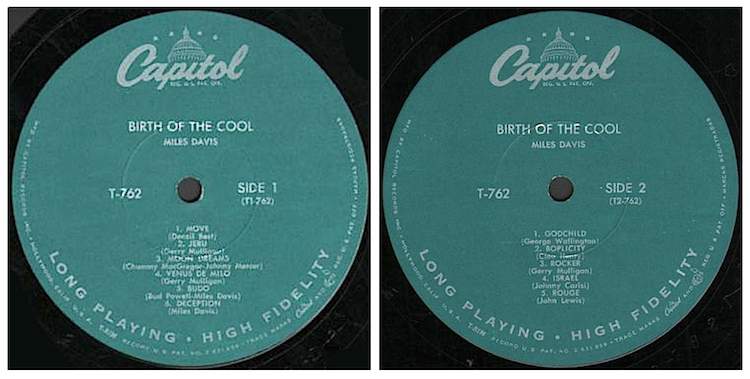THE BIRTH OF THE COOL ON CAPITOL RECORDS
SETTING THE RECORD STRAIGHT (12” LPs)
T-762 [1957]
PART THREE
© James A. Harrod, Copyright Protected, All Rights Reserved
I am in the process of moving my work on this platform to a new home that unites all of my jazz research under one roof. Thank you for looking at my work here at google blogger. I think you will find the new home more user friendly with links and tags to all of my research. This link will take you to this research at the new site.
Eleven of the twelve tunes recorded by the various Miles Davis ensembles in January and April of 1949 and March of 1950 that had been released over four 10” LPs as noted in Part Two of this series were finally united on a single 12” LP release in 1957.
The following full page ad ran in the March 6, 1957 issue of Down Beat and the March 1957 issue of Metronome magazine.
(enlargement from above ad)
The cover featured a photo of Miles Davis taken by Aram Avakian. The album title, BIRTH OF THE COOL, was featured in the upper left corner of the cover, all capital letters in white except for “COOL” in a shade of red/orange. Miles’ name was spelled out in all lower case letters in white in the center of the cover. The eleven tunes were also spelled out on the cover in white lower case letters in the lower right corner.
William “PoPsie” Randolph was present at the original January 1949 recording session and took numerous photos of the group including close-ups of Al Haig, Miles Davis, Lee Konitz and Gerry Mulligan. Herman Leonard was also present at the Royal Roost in September of 1948 when Miles Davis had booked his ensemble into the club for a two week gig. One photo survives in Leonard’s archive and can be viewed at the Morrison Hotel Gallery. The photo captures Max Roach at the left, Miles in the center with Mike Zwerin at the right. Herman Leonard cropped this photo eliminating Roach and Zwerin to feature Miles only in his first published collection of jazz photography, L’ŒIL DU JAZZ. None of the vinyl LP releases of the “Birth of the Cool” sessions would feature photos by Popsie or Leonard.
The original labels of Capitol T-762 featured a turquoise background. The album proved to be a best seller for Capitol and remained in the catalogue for a number of years. Later pressings of T-762 featured the “rainbow” label with a multi colored band surrounding the central label in black with the Capitol Records logo at the left of the center hole (Canadian pressing) and above the album title, (U.S. pressing).
Metronome did not review T-762 until their August 1957 issue when reviewer Bill Coss wrote a short paragraph in their column devoted to reissues.
Down Beat featured a two part examination of THE BIRTH OF THE COOL in their May 2 & 16, 1957 issues written by Nat Hentoff. Hentoff focuses on the role of Gil Evans and the genesis of The Birth of the Cool in the Claude Thornhill orchestra.
(Down Beat articles © Maher Publications)
Capitol Records would repackage and reissue the BIRTH OF THE COOL in 1965 as DT-1974 in their “Dimensions in Jazz” series and in 1972 as MILES DAVIS AND HIS ORCHESTRA - THE COMPLETE BIRTH OF THE COOL, Capitol M-11026, CAPITOL JAZZ CLASSICS VOL. 1. These will be examined in subsequent posts.

+449.jpg)











.jpg)


































